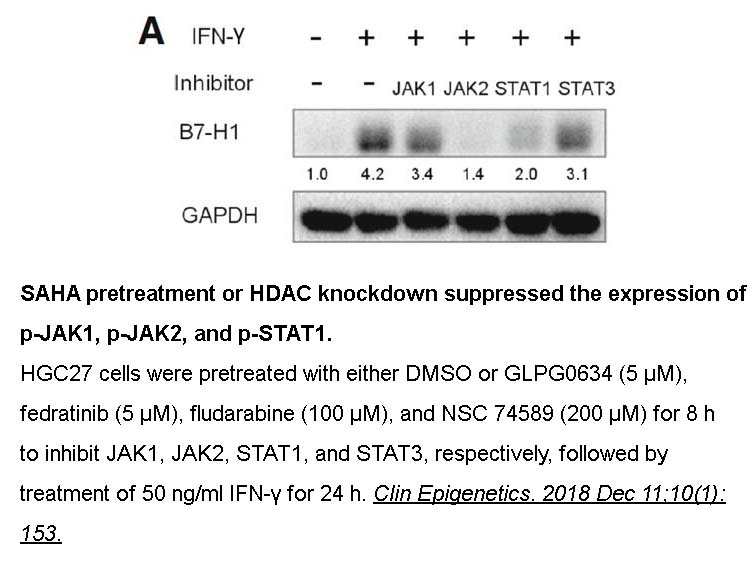GLPG0634
GLPG0634 is a selective inhibitor of JAK1 with IC50 value of 10nM [1].
GLPG0634 is a small molecule inhibitor of JAK1. It shows potent inhibitory activity against both JAK1 and JAK2 with IC50 values of 10nM and 28nM, respectively. In cellular assays, GLPG0634 is most potent in inhibiting the JAK1/JAK3/γc signaling induced by IL-2– and IL-4 as well as the JAK1/TYK2 type II receptor signaling induced by IFN-αB2. However, it shows lower potent to inhibit JAK2 homodimer–mediated signaling induced by EPO or PRL. It demonstrates that GLPG0634 is specific to JAK1. In addition, GLPG0634 is found to inhibit the phosphorylation of STAT1 and STAT5 induced by cytokines. Moreover, GLPG0634 inhibits the differentiation of Th1 and Th2 cells with similar potencies. Th17 differentiation is also affected by GLPG0634 with a lower potency [1].
In the rat model of collagen-induced arthritis (CIA), oral administration of GLPG0634 shows a marked protection from bone damage at dose of 3 mg/kg. It reduces the infiltration of inflammatory cells significantly from 1 mg/kg onward [1].
References:
[1] Van Rompaey L, Galien R, van der Aar E M, et al. Preclinical characterization of GLPG0634, a selective inhibitor of JAK1, for the treatment of inflammatory diseases. The Journal of Immunology, 2013, 191(7): 3568-3577.
- 1. Hua Cai, Siyu Chen, et al. "Interleukin-22 receptor 1-mediated stimulation of T-type Ca2+?channels enhances sensory neuronal excitability through the tyrosine-protein kinase Lyn-dependent." Cell Commun Signal. 2024 Jun 3;22(1):307. PMID: 38831315
- 2. Deng R, Zhang P, et al. "HDAC is indispensable for IFN-γ-induced B7-H1 expression in gastric cancer." Clin Epigenetics. 2018 Dec 11;10(1):153. PMID:30537988
| Storage | Store at -20°C |
| M.Wt | 425.5 |
| Cas No. | 1206161-97-8 |
| Formula | C21H23N5O3S |
| Solubility | ≥21.3 mg/mL in DMSO; insoluble in EtOH; insoluble in H2O |
| Chemical Name | N-[5-[4-[(1,1-dioxo-1,4-thiazinan-4-yl)methyl]phenyl]-[1,2,4]triazolo[1,5-a]pyridin-2-yl]cyclopropanecarboxamide |
| SDF | Download SDF |
| Canonical SMILES | C1CC1C(=O)NC2=NN3C(=N2)C=CC=C3C4=CC=C(C=C4)CN5CCS(=O)(=O)CC5 |
| Shipping Condition | Small Molecules with Blue Ice, Modified Nucleotides with Dry Ice. |
| General tips | We do not recommend long-term storage for the solution, please use it up soon. |
| Cell experiment [1]: | |
|
Cell lines |
THP-1 cells (ATCC TIB-202) |
|
Preparation method |
The solubility of this compound in DMSO is >21.3mg/mL. General tips for obtaining a higher concentration: Please warm the tube at 37℃ for 10 minutes and/or shake it in the ultrasonic bath for a while. Stock solution can be stored below -20℃ for several months. |
|
Reacting condition |
1 μM |
|
Applications |
In THP-1 cells, GLPG0634 preferentially inhibited JAK signaling complexes containing JAK1 and also inhibited Th1 differentiation with similar potencies of 1 μM or lower. |
| Animal experiment [2]: | |
|
Animal models |
Male Sprague Dawley rats (180–200 g) and CD1 mice (23–25 g) |
|
Dosage form |
orally dosed as a single esophageal gavage at 5 mg/kg (dosing volume of 5 ml/kg) and i.v. dosed as a bolus via the caudal vein at 1 mg/kg (dosing volume of 5 ml/kg) |
|
Application |
GLPG0634 dose-dependently reduced inflammation, cartilage, and bone degradation in the CIA model in rats and mice with significant effect of 3 mg/kg. Protection from bone damage was evidenced by a dose-dependent reduction, with significant effect from GLPG0634 (3 mg/kg), showed a marked reduction of the infiltration of inflammatory cells while protecting the articular cartilage and bone from 1 mg/kg onward. |
|
Other notes |
Please test the solubility of all compounds indoor, and the actual solubility may slightly differ with the theoretical value. This is caused by an experimental system error and it is normal. |
|
References: [1]. Van Rompaey L, Galien R, van der Aar E M., et al. Preclinical characterization of GLPG0634, a selective inhibitor of JAK1, for the treatment of inflammatory diseases. The Journal of Immunology, 2013, 191(7): 3568-3577. |
|
Quality Control & MSDS
- View current batch:
Chemical structure

Related Biological Data








